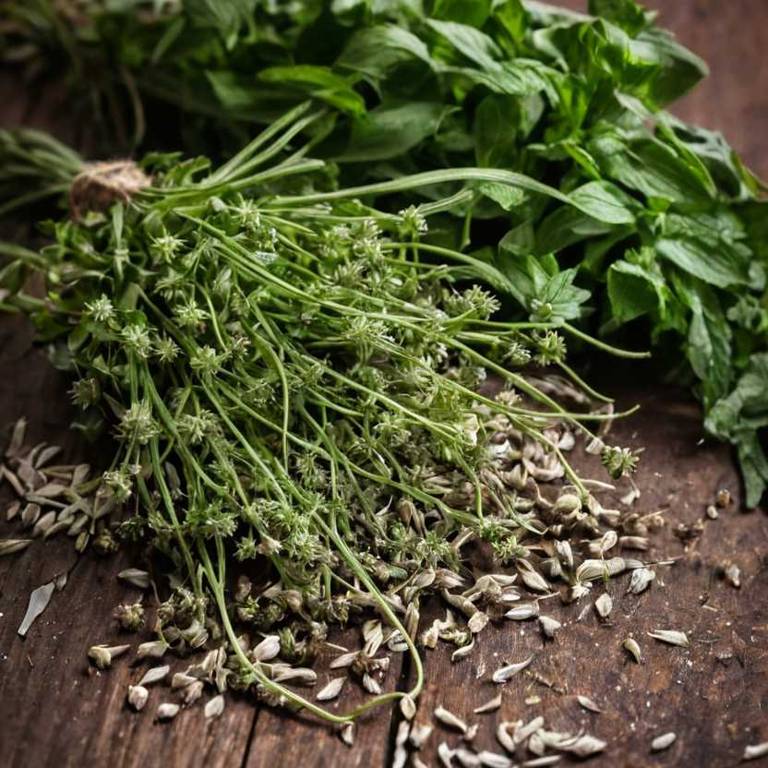Broadleaf Plantain (Plantago Lanceolata)
Information Reliability Score: 5/10
This score reflects the overall reliability of the information presented in this article. It is based on the quality of scientific evidence, accuracy of sources, and the transparency of references related to Plantago lanceolata.

Broadleaf Plantain, scientifically known as Plantago lanceolata, is a medicinal herb widely recognized for its healing properties and adaptogenic qualities.
It has been used for centuries in traditional medicine to support respiratory, digestive, and skin health due to its high content of mucilage, antioxidants, and anti-inflammatory compounds. Historically, it was employed by Native American tribes and ancient civilizations to treat wounds, ulcers, and gastrointestinal issues, while also serving as a natural remedy for coughs and bronchitis. In modern wellness practices, Broadleaf Plantain is valued for its potential to soothe inflammation, improve gut health, and support immune function, often found in herbal teas, topical salves, and dietary supplements.
One of its unique features is its distinctive bitter taste and the presence of allantoin, a rare compound known for its skin-soothing and cell-regenerating properties, making it a standout in both traditional and contemporary herbal medicine.
FREE CHECKLIST
The Only 10 Herbs You Need to Heal 90% of Common Ailments.

Table of Contents
Scientific and Botanical Profile
Broadleaf Plantain, with botanical name Plantago lanceolata, is a herbaceous perennial belonging to the family Plantaginaceae.
Native to Europe, Asia, North Africa, Western Asia, the Middle East, Central Asia, and Northern Africa, it is widely distributed across temperate regions. Morphologically, it is characterized by broad, lance-shaped leaves that are ribbed and covered with fine, silky hairs, giving it a woolly appearance, hence its common names Woolly Plantain and Broadleaf Plantain. The plant produces erect, slender flowering stems topped with a dense cluster of small, greenish-white flowers.
It is commonly known as Common Plantain or Broadleaf Plantain, and is often found in disturbed soils, roadsides, and meadows.
History and Cultural Relevance
Broadleaf Plantain was used by ancient civilizations such as the Greeks, Romans, and Chinese for its medicinal properties, with records dating back over 2,000 years.
In traditional medicine systems, it was valued for its ability to heal wounds, reduce inflammation, and treat skin conditions, often applied topically as a poultice or salve. The plant also held cultural significance in various societies, where it was incorporated into folk rituals and considered a symbol of resilience and renewal, often used in herbal remedies passed down through generations. Today, its traditional remedies—such as treating minor cuts, burns, and respiratory ailments—remain relevant, with modern herbalists and naturopaths still utilizing its healing properties.
Broadleaf Plantain continues to be a staple in both historical and contemporary herbal practices, bridging ancient wisdom with modern natural health approaches.
Chemical Composition and Nutritional Profile
Broadleaf Plantain contains a diverse array of bioactive compounds, including alkaloids, flavonoids, and terpenes, which contribute to its medicinal properties.
It is also rich in essential oils, which provide antimicrobial and anti-inflammatory benefits. Nutritionally, it offers a good source of vitamins such as A, C, and B-complex, along with minerals like potassium, calcium, and magnesium. The antioxidants present in Broadleaf Plantain help neutralize free radicals, supporting the body's defense against oxidative stress.
Its compounds work synergistically to reduce inflammation, promote wound healing, and support digestive health by interacting with cellular receptors and modulating immune responses.
Medicinal Properties and Health Benefits
Plantago lanceolata has been widely recognized for its potent medicinal properties, offering benefits across multiple body systems, including the respiratory, digestive, and immune systems.
Its leaves contain mucilage, which soothes inflammation and aids in reducing coughing and bronchial irritation, making it particularly effective for respiratory conditions such as bronchitis and asthma. Additionally, it supports digestive health by easing symptoms of irritable bowel syndrome and promoting the healing of ulcers due to its anti-inflammatory and antimicrobial properties. Compared to similar herbs like Plantago ovata (psyllium), which is primarily used for constipation due to its high fiber content, Plantago lanceolata stands out for its broader therapeutic range and stronger anti-inflammatory effects.
Its versatility and potency make it a valuable herb in both traditional and modern herbal medicine.
Discover the 10 best health benefits of Broadleaf Plantain.
Forms, Preparation and Usage
Plantago lanceolata has a variety of forms available, including fresh leaves, dried plant material, tinctures, powders, essential oils, and capsules, making it versatile for different applications.
It can be prepared as a tea by steeping dried leaves in hot water, or as a decoction by simmering the plant for a longer period to extract more potent compounds. Topical preparations, such as poultices or salves, are also common for skin conditions, while essential oils derived from the plant can be used in aromatherapy. For adults, a typical dosage is 1-2 cups of tea per day, while children may use a reduced dose under medical supervision if deemed safe.
It is recommended to use plantago lanceolata for short durations, typically up to two weeks, to avoid potential overuse and ensure safety.
Safety, Side Effects and Contraindications
Plantago lanceolata can be used as a traditional herbal remedy for its anti-inflammatory and mild laxative properties, but it should be used with caution due to potential side effects and interactions.
While generally considered safe in moderate amounts, excessive use may lead to gastrointestinal discomfort, including bloating, flatulence, and diarrhea. It may interact with medications such as diuretics, laxatives, and anticoagulants, potentially increasing the risk of dehydration or bleeding. Pregnant and breastfeeding women should avoid plantago lanceolata due to insufficient safety data, and individuals with chronic conditions like diabetes or hypertension should consult a healthcare provider before use.
To ensure safety, it is advisable to use plantago lanceolata in recommended dosages, consult a healthcare professional, and discontinue use if adverse effects occur.
Growing, Harvesting and Storage
Plantago lanceolata grows best in well-drained, loamy soil that is rich in organic matter, with a pH range of 6.
0 to 7. 5, and it thrives in full sun to partial shade. It requires regular watering, especially during dry periods, but it is drought-tolerant once established. To ensure optimal growth, it should be planted in early spring or fall, and mulching around the base can help retain moisture and suppress weeds. For harvesting, the best time is during late summer to early autumn when the leaves are fully developed and the plant is at its peak potency. The leaves should be cut with clean shears or scissors, leaving a portion of the stem to encourage regrowth, and then dried in a cool, shaded area or in a dehydrator to preserve their medicinal properties.
Once dried, the plant material should be stored in airtight containers in a cool, dark place to maintain potency and extend shelf life.